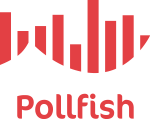How to Execute an Efficient Agile Research Strategy with 4 Steps
How to Execute an Efficient Agile Research Strategy with 4 Steps
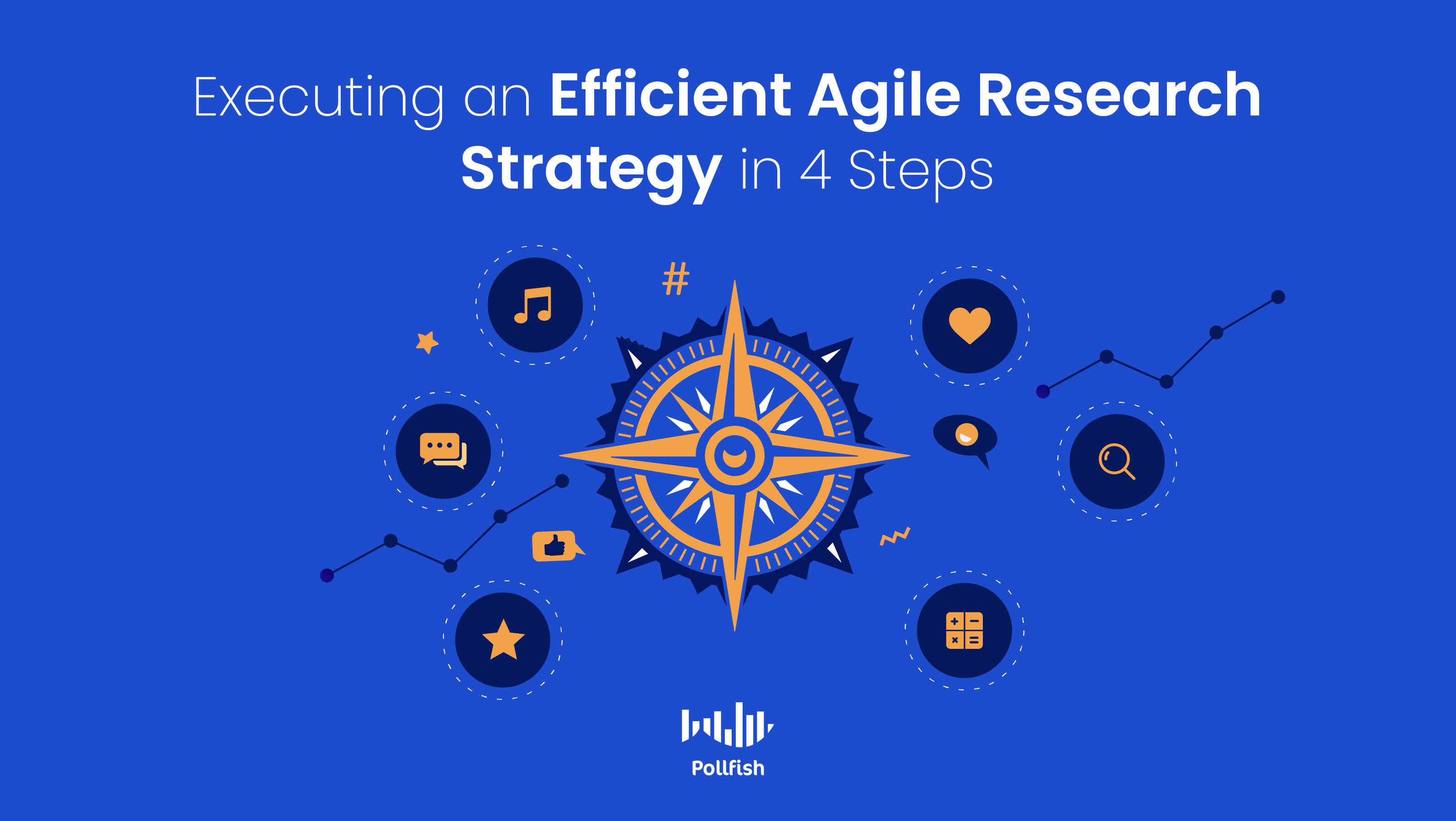
Executing an agile research strategy goes far beyond working quickly. Rather, it involves agile software development methods, along with following several best practices. Coupling these key aspects allows businesses to become well-suited to performing agile research.
Becoming a truly agile organization has a powerful impact across departments, even affecting business expenditures. In fact, a Harvard study found that by the end of the agile transition, CEOs spend four times the amount of time on research strategy, at 10% - 40%.
93% of businesses that had fully adopted an agile research strategy before the COVID-19 pandemic outperformed businesses that hadn’t. Clearly, using an agile research strategy is a key component of business operations and success.
This article explains the meaning behind the agile research strategy, its importance, benefits, how to execute it efficiently with four steps, and how surveys are the best bet for software development methods.
Understanding Agile Research Strategy
Agile research strategy is a four-step strategy that falls under agile market research, an approach characterized by accelerating market research operations and processes to ensure timely and efficient results.
There are several best practices that make up this strategy. Since it falls under agile market research, these strategies also involve using agile software and development methods that are iterative in nature.
The iterative approach involves taking small steps towards an end goal, where each step informs the next and involves iterating tests, as opposed to the waterfall approach, which involves completing a project in one go.
The agile research strategy builds off of this iterative approach and can be used in the strategic planning process. In order to truly be agile, this strategy requires coupling on-demand technology with a four-step iterative process.
The Importance of the Agile Research Strategy
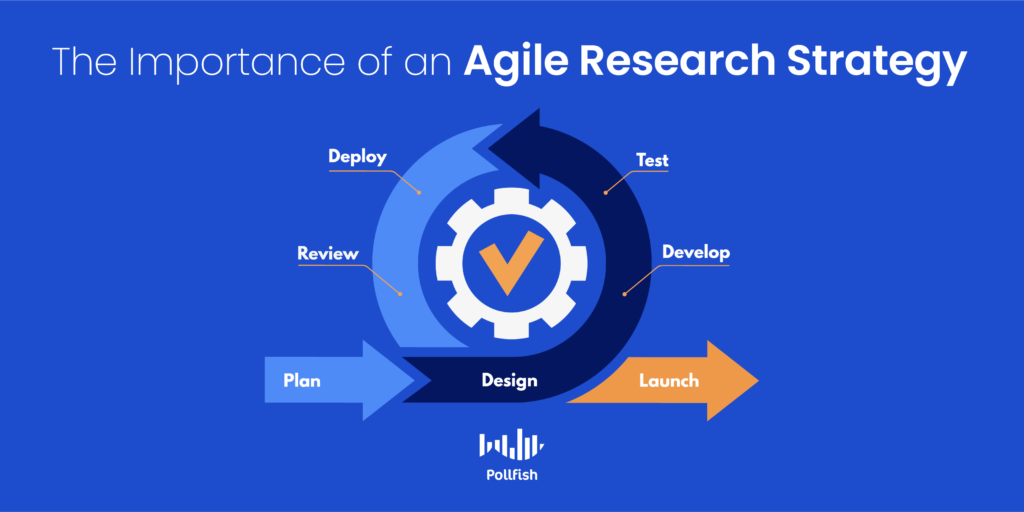
Having an agile research strategy is important on many fronts. First and foremost, it is one of the major aspects that uphold agile market research, working in tandem with the agile technology that helps bring any research campaign to completion.
Secondly, this kind of strategy allows researchers and their business at large, to work much faster and become more productive. This is because the agile method relies heavily on using AI and automation market research platforms, the kinds that remove manual, repetitive work from the research process.
It’s also because the strategy involves a great deal of planning, testing, and understanding customers and other research subjects down to a T, as the following section explains.
This strategy allows businesses to perfect a variety of business campaigns, and to do so in an informed and data-backed manner. The agile research strategy works to improve everything from branding and brand visibility to concept testing and customer development.
Essentially, this strategy underpins and strengthens all the processes that are involved in various business campaigns — marketing or otherwise. It helps researchers and other team members better work together, as it typically involves collaborations across departments to reach alignment across goals.
In this way, it brings the democratization of data into play, meaning that all team members can work with data, even those who are non-technical. This is because each step in the strategy is methodical and one designed to help teams conduct and use market research better.
4 Tips on Best Practices for Agile Research Strategy
Brands can execute an informed agile research strategy by adhering to four stages, or steps. This section examines each of these four stages individually, what to do in each, and how these steps ensure quality results.
Foundational Learning
The first stage in the four-step strategy, foundational learning is used for building a strong foundation for the rest of the process. Brands build the foundation via compiling the needs of their target market. This includes their demographics, psychographics, desires, and needs.
Businesses must study their customers directly to obtain this data. They can do so by conducting a focus group, survey panel, or consumer survey. Brands must use the proper market research software or technology to be agile, as these methods can be increasingly time-consuming and difficult to perform in traditional ways.
However a business chooses to construct market research, it should ask questions that allow it to engage in foundational learning. As such, they should tap into areas such as demographics, brand awareness, customer behavior, preferences, and much more.
Businesses can get access to these insights with both qualitative and quantitative market research but must rely on an agile market research platform to deliver these insights.
Innovation Pipeline
The innovation pipeline stage deals with business strategy. This stage should apply the information that businesses garnered from the foundational learning step and apply it across various market research and marketing campaigns.
For example, businesses can use the data they reaped from the first step and use it to build customer personas, tweak their marketing messages, tailor products and innovate on product features, along with broadly connecting with their target market by addressing their needs or speaking with them via representatives.
To do so, brands should identify all kinds of customer behaviors to understand category opportunities and their consumers’ unmet needs. They should continue studying their customers' unique needs at a more granular level, such as with follow-up studies.
Product testing is another crucial element in this stage, as it is still early in the process and the most important iterations occur from survey responses on product ideas and sentiment. Doing so allows businesses to go to market with more confidence that their products meet their consumer needs.
Brands should also validate iterations against competitors’ products, as it will give them a competitive advantage.
When a business reaches parity or superiority in its benchmarks, and consumers detect it, the business will be in a sweet spot and can proceed to develop its campaigns.
Campaign Development
This stage involves developing marketing campaigns supported by strategic research in order to form brand equity, foster awareness, and drive demand. It shows that a good product is not enough to succeed.
Much like creating innovative products, businesses should rely on market research in this step, incorporating things like user panels, foundational learning, iterative tactics, alongside qualitative and quantitative research.
After businesses create campaign ideas based on their target market comprehension, they can test new ads with their consumers. The feedback from this activity is used to iterate and conduct tests. This allows businesses to fine-tune their campaigns and their corresponding messaging, and branding. By iterating and testing, brands can understand the effectiveness of their copy, imagery, and more.
Businesses should continue this work until their benchmarks are outperformed and campaigns are ready to go to market.
Shopper/ Tracking Support
While campaign development is a crucial step in the agile research strategy, it is not the final one. This is because markets and consumers are constantly evolving; businesses ought to remain agile and attentive to sustain a competitive advantage.
As such, there is work to be done after products are tested, iterated, and launched along with their marketing campaigns.
In this final stage, brands should evaluate their shopper and customer support experience. This involves studying the in-store experience, customer interactions with personnel, including those that offer support, along with studying retail assets.
This step is partially used to make forecasts on current markets to ensure effective future campaigns. Although it is impossible to precisely predict markets, businesses can still make accurate predictions by following this four-step strategy. But they must carry out these stages using the correct market research software, the kind that provides agile data.
How Surveys Complement Agile Research Strategy
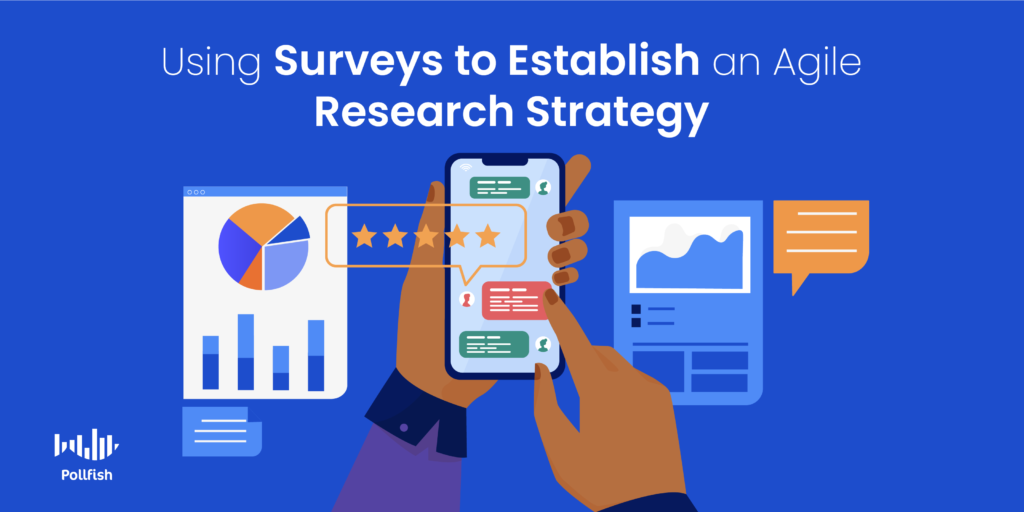
Given that the majority of agile research strategy involves iteration and testing, surveys — particularly online surveys — are crucial and trustworthy tools to use. They enable brands to extract virtually any kind of customer opinion, sentiment, or need.
This is because surveys allow brands to ask any question and deploy the questionnaire to their target audience. Businesses can use surveys for any campaign, from branding and general marketing to product strategy, and customer experience evaluation. Some online survey platforms even allow market researchers to A/B test concepts concurrently with their surveys.
As such, researchers can iterate concepts with surveys on hand. If customers respond negatively or less enthusiastically than expected to on a concept, a business can test another one by simply deploying another survey.
Surveys can also be used to better understand the overall shopping experience, as described in the final step, as brands can deploy surveys that address their own CX. All in all, surveys can be applied to a variety of campaigns, including pre and post-campaign market research, allowing brands to establish an efficient agile research strategy.
Making Headway in Agile Research
Agile market research is no longer a buzzword, despite the fact that not everyone shares the same definition of it and applies it to slightly different areas of research, along with different objectives.
To reiterate, agile market research is the application of agile software methods (think iterative activities with market research practices, such as the agile research strategy. This strategy dictates how to test, iterate, and launch products, concepts, and campaigns more efficiently and quickly via a customer-centric approach.
In order to facilitate a strong agile research strategy, brands must use an agile market research platform. An online survey platform is brands’ and market researchers’ best bet, as it allows for customer targeting, survey creation, deployment, and post-results data filtering.
A strong online survey platform should obtain high-quality data, which can be executed with the RDE (random device engagement) sampling method. This method engages customers in their natural digital environments in a completely randomized way.
Such a platform must also rely on artificial intelligence to perform quality checks that ensure that brands extract only the highest quality of customer data. These checks should disqualify VPN users, gibberish answers, incomplete surveys, and other sources of poor data from appearing in the final survey results.
When a business uses such an online survey platform, it can seamlessly perform an agile research strategy.
How to Uncover and Minimize Business Risks with Surveys
How to Uncover and Minimize Business Risks with Surveys
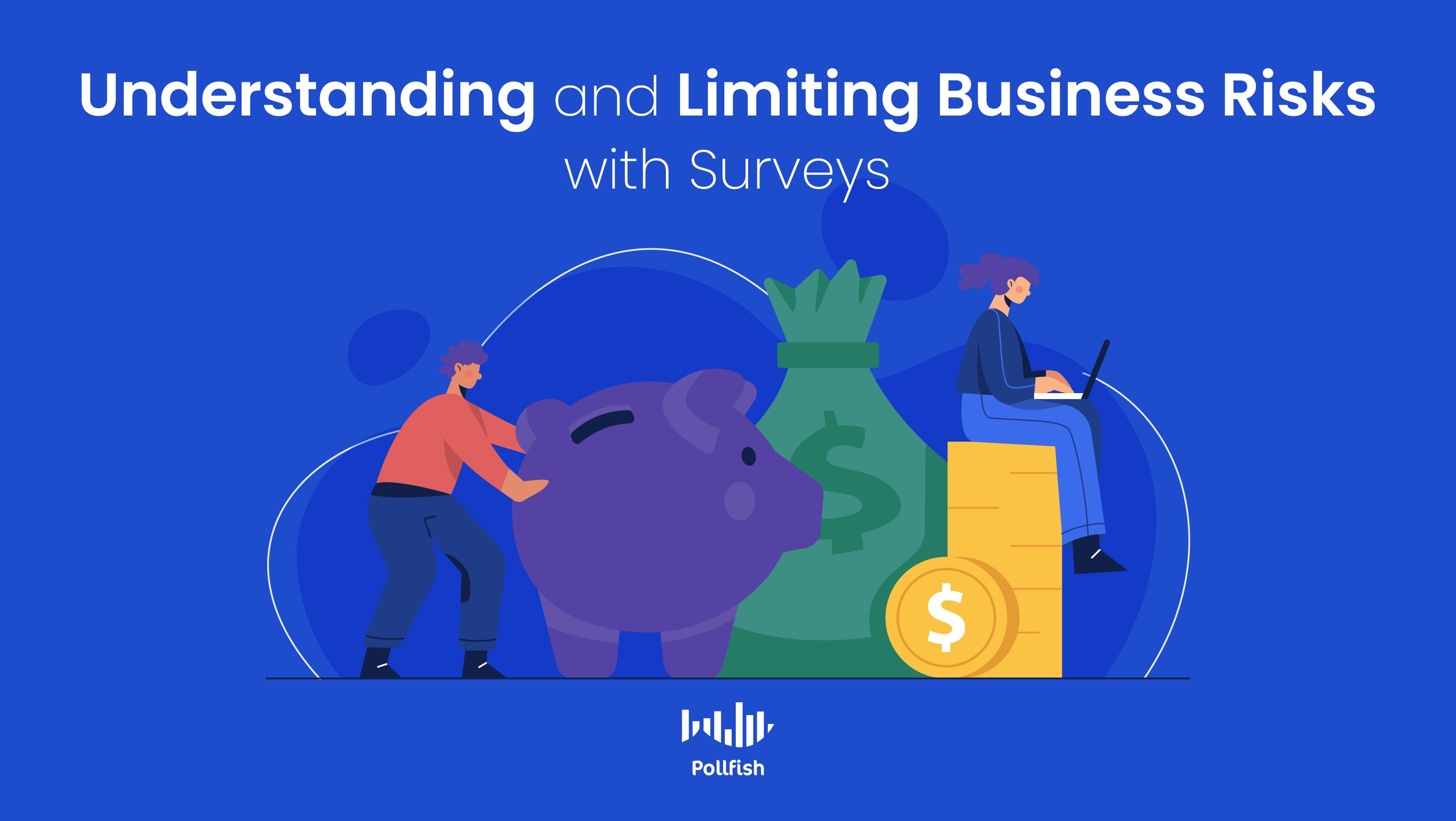
Businesses must work towards uncovering and preventing business risks, as running a business is often a risky operation — especially for fledgling companies. For a fourth of new businesses, failure is imminent, as 20% of businesses fail within the first year.
The leading worldwide business risk is business interruption at 41%, which includes supply chain disruption. The next most common risks for businesses are pandemic outbreaks – 40%,
Cyber incidents – 40% and market developments – 19%.
While it is impossible to be immune to all business risks, a well-prepared business can lessen and even avoid risks in some cases, with the use of data-driven decision making. They can also do this by honing in on their business strategy.
This article explores business risks and how surveys can be used to discover and minimize them early on.
Understanding Business Risks
Business risks refer to any threat a company may experience in its ability to achieve its financial goals. A risk can also mean that a business’s plans may not turn out as they were originally planned or that they do not meet their targets, objectives, or KPIs.
A risk can also include the chance of exposure to any factors that lower a business’s profit and chances of success. These factors can vary, ranging from internal business risk factors, such as technological, human, physical, structural, political, mismanagement, etc.
There are various risks that cannot be blamed on a business itself, which include external factors, such as increased prices of raw materials, a new pool of competitors, and government regulations.
Virtually anything that threatens a company from achieving its financial goals can be considered a business risk. As such, businesses need to be aware of all their possible risks, how to counteract them, and mainly, how to prevent them from causing any impact.
There are also external risk factors that a business can rein in or reduce, such as those present in target market demands, customer behavior, and tastes. To do so, businesses must take part in a strategic planning process and create business safety nets.
The Main Types of Business Risks
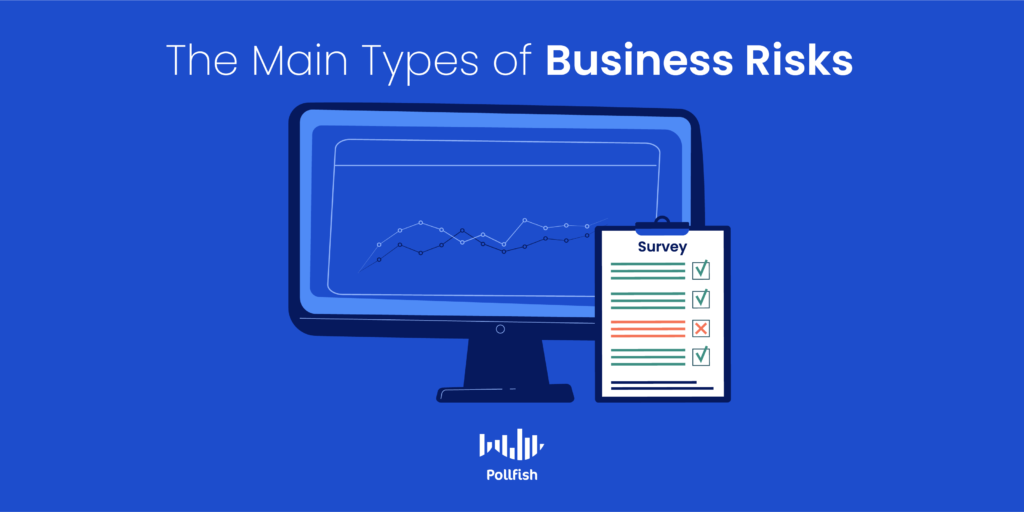
While there are various kinds of business risks, businesses can better identify them and remember them by understanding their broader categories. The two main types of business risks are internal and external. In this binary, each category has the power to affect the other.
The following lists the main types of risks businesses can experience, along with their various major subcategories
Internal Business Risks
Internal risks occur from within a company and can result in various setbacks every now and then. These risks can be predicted reliably, as they emerge from a business itself. Businesses have a good chance of reducing these kinds of risks.
Here are several major internal risks that a business can face:
- Human risks:
- Union strikes
- Employee performance, including idle workers
- Ineffective management and/ or leadership
- Poor relationships with external producers or suppliers
- Clients and customers who fail to pay on time
- Physical risks:
- Loss of or damage of company assets
- Loss or damage of office equipment and buildings
- In-office physical risks such as issues (even minor) in building/ wall structure
- Crimes such as theft and vandalism
- Technological risks:
- Product and service changes in the manufacturing, delivery, or distribution
- Outdated operating systems that decrease production or cause disruptions in supplies or inventory.
- A lack of IT staff investing that supports company systems
- Server and software issues leading to equipment downtime
- Production deficits
External Business Risks
These risks often include economic events outside of the business’s structure. External factors can be unexpected and take a turn for the worse, as they involve virtually any undesirable outside force or phenomenon. It can be more difficult to reduce these risks given that they cannot be forecasted effectively.
Identifying Business Risks
Risks are identified in a number of ways. Strategies to identify these risks rely on comprehensively analyzing a company's specific business activities. Most organizations face preventable, strategic, and external threats that can be managed through acceptance, transfer, reduction, or elimination.
The following are several major external risks that a business can face:
- Natural risks:
- Natural disasters that affect business operations such as remaining open.
- Damages to office buildings and merchandise
- Being forced to shut down temporarily or reduce hours of operation
- Political and legislative risks:
- Changes in the political, environmental, or governmental policy
- Changes in import and export laws, taxes, tariffs
- Legal risks
- Regulations that may seem unwarranted or affect a business negatively
- Compliance policies such as data protection and payment processing
- Economic risks:
- Changes in market conditions
- Economic downturns such as recessions
- Increased levels of unemployment
- Entry of new competitors
- Revenue loss
- Changes to customer buying behavior
- Security and fraud risks
- Hacking opportunities across channels
- Data breaches
- Payment fraud
- Reputation risks
- Dissatisfied customers
- Product failures or dissatisfaction with products
- Lawsuits
- Negative press
- Damage to brand equity
How Surveys Uncover and Reduce Business Risks
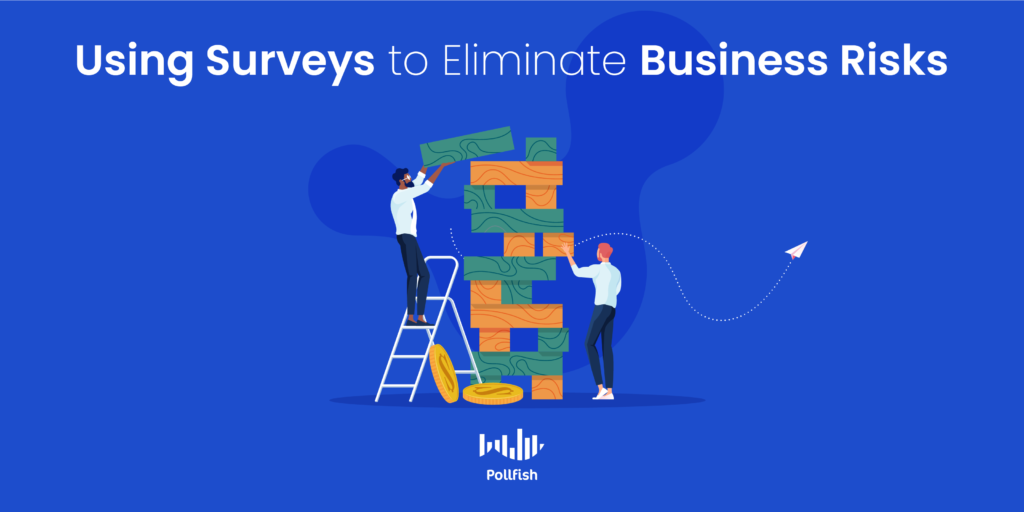
There are many ways to identify the two major risks within an organization. Given the varying nature of business risks, businesses must implement several strategies to uncover and reduce them, if not completely eradicate them.
These methods include conducting secondary market research to identify industry-specific risks, analyzing customer complaints via a VoC (voice of the customer program), conducting internal and external research, analyzing any suspected risk sources and other means.
Fortunately, surveys provide a direct approach to tackling many of these ways to uncover and reduce risks. This is because surveys can be used to study virtually any topic or concern of interest.
Surveys complement secondary market research, as they provide business-specific information, granting market researchers the opportunity to ask their own questions and to use a precise survey sample based on the required target population.
Surveys allow researchers to gain firsthand insight into their customers. They can dig further into customer complaints, by assessing the number of people within a target market that share the same concerns and may have the same complaints. In this way, they provide qualitative market research in addition to quantitative market research.
While there are many unforeseen changes that can occur, businesses can make them more predictable and therefore, manageable by conducting surveys. This is because businesses can use these tools to gain insight into various markets, including global ones via global market research.
They can assess whether external factors have any bearing on their customers and how to best respond to them. In this way, businesses can both uncover and minimize their risks with surveys. As such, surveys can also be used to compare a business with its competitors, helping to assure that the business doesn't fall behind and risk losing market share.
Implementing surveys is also valuable for branding, as they can be used for brand tracking, helping businesses keep track of their reputation, and warding off reputational risks.
In this way, market researchers can set up such survey campaigns to gain access into the public opinions of their business. They can research how their current branding, advertising, and PR campaigns are faring with their target market. They can also do this with A/B testing.
All in all, although business risks vary in nature and impact on a business, surveys help counter the risks by identifying them and preparing researchers to mitigate them.
Preventing all Undesirable Business Happenings
Businesses must equip themselves with all the necessary tools and strategies to help them identify and reduce business risks. As such, there is no single solution to these risks.
However, surveys provide an excellent source of customer and even competitor information that can inform businesses on their risk factors and overall environment. In order to reap the most benefits out of surveys and effectively reduce risks, businesses must choose the proper online survey platform. Such a platform should make it easy to create and deploy surveys and have the capability to distribute surveys to a massive network while ensuring they are answered by the targeted population.
In addition, a strong survey platform should extract quality data, which is made possible through the RDE (random device engagement) sampling method, which engages respondents in their natural digital habitats in a completely randomized way. It should also rely on artificial intelligence to perform quality checks that ensure the highest quality of customer data.
When a company uses an online survey platform of this caliber, it is setting itself up for success and mitigating its risks.
Diving into the Diversity and Inclusion Survey
Diving into the Diversity and Inclusion Survey
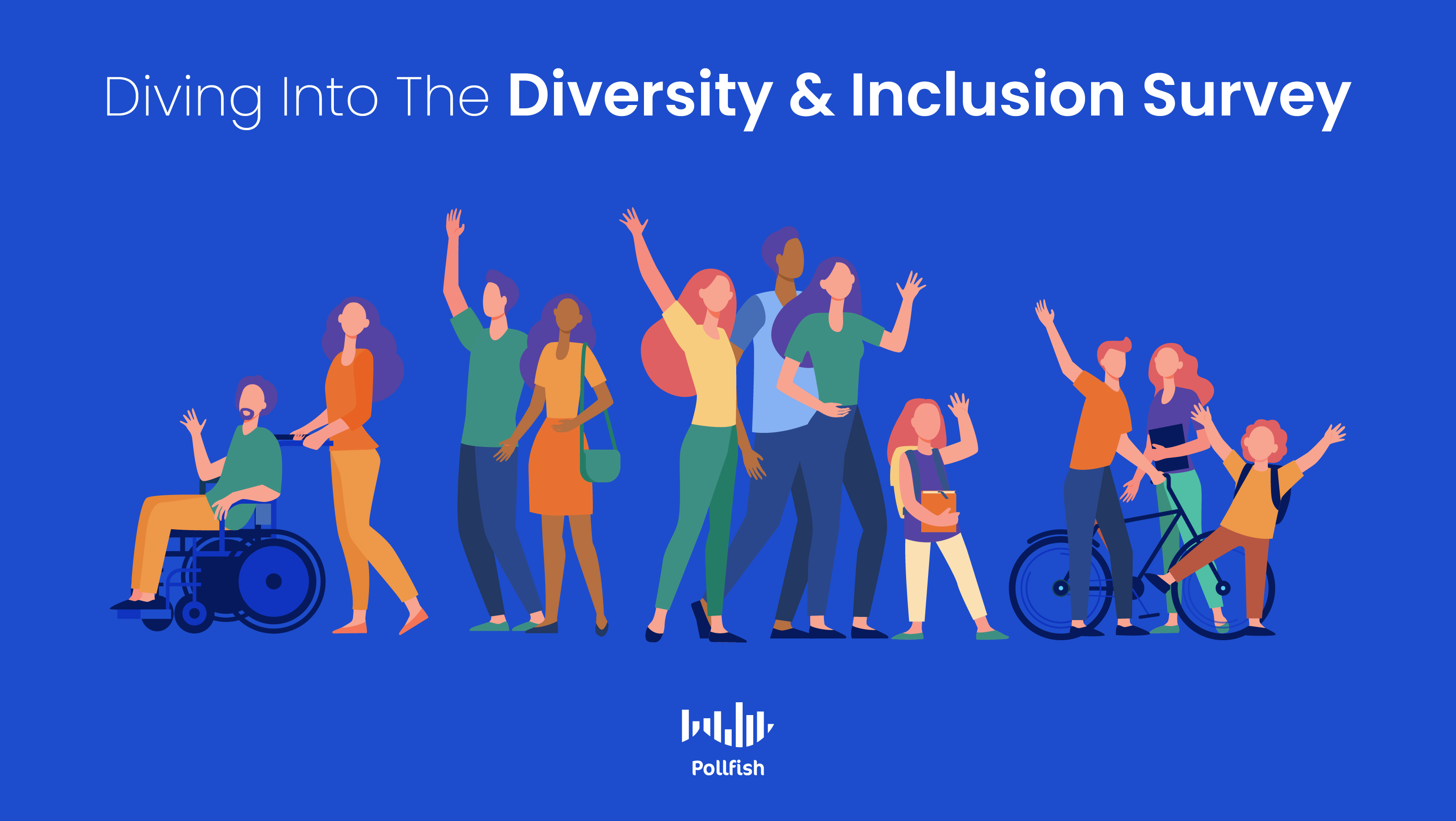
Businesses conduct diversity and inclusion surveys to improve their work culture and the overall employee experience. They do this by gauging their staff’s perspectives and making possible improvements to the general company culture and structure.
According to McKinsey, organizations within the top diversity quartile have 21% sound financial performance than organizations in the bottom quartile. Diversity also correlates with higher innovation rates.
A practical starting point to foster an inclusive and diverse environment within a workplace relies on conducting an organization-wide diversity and inclusion survey to gather the employees’ feedback on this matter.
By garnering and analyzing this data, you can better comprehend the current organization status and create a clear path to cultivating D&I.
This article expounds on the key characteristics of diversity and inclusion surveys, their importance, and how to carry out one effectively.
Defining the Diversity and Inclusion Survey
The diversity and inclusion survey is a kind of employee feedback survey, part of the Voice of Employee (VoE) studies that assess employee groups and their experiences in their company. These surveys measure diversity, inclusion, and fairness at your workplace.
With diversity and inclusion surveys, you can ensure that all people are treated justly and equally, regardless of their gender, age, sexual orientation, race, ethnicity, disability, religion, or other factors.
Ultimately, this helps build an inclusive culture that drives organizational effectiveness. Essentially, diversity and inclusion surveys enable you to:
- Identify specific groups who aren’t getting the same experience as others
- Take appropriate initiatives to promote inclusion and diversity
- Review procedures and policies and set relevant groups as appropriate
- Recognize if the bias is unconscious
All in all, diversity and inclusion surveys help you to track your company’s progress towards creating an environment where people are accepted for their beliefs and respected for their values. For example, if your survey shows that workplace sentiments have increased, that means positive progress has been made towards diversity and inclusivity at work.
The Key Characteristics of the Diversity and Inclusion Survey
These surveys give companies an anonymous and accurate depiction of how fair and inclusive that employees feel about their organization’s culture and employee relations.
Diversity and Inclusion is a sensitive topic that employees feel strongly about. For starters, your diversity and inclusion survey should include actionable, straightforward questions that help you gauge how different groups find your workplace culture and emphasize areas for improvement.
Some of the key characteristics of a diversity and inclusion survey include:
- A clear objective for the survey
- 3-6 questions in length
- Periodic check-ins on the same audience
- Use of simple language
- Use close-ended or multiple-choice questions
The Importance of a Diversity and Inclusion Survey
It is implausible to address the problems of communication gaps and cultural misunderstandings if companies don't know they exist within the organization. While inclusion, equity, and diversity are not always visible and tangible aspects, surveys provide a viable solution to quantify and measure these immaterial concepts at the workplace.
Most companies are paving the way to cultivating an inclusive environment at the workplace. The diversity and inclusion survey initiatives are more crucial than ever to address disparity issues in the workplace. According to McKinsey's research, the lack of diversity could have significant financial consequences.
Companies can achieve 50% higher profits and share performance if women employees are represented better at the company. Similarly, senior-level female employees have a more meaningful impact on the company’s culture. They are more likely to welcome employee-friendly policies and fight for gender and racial disparity.
Additionally, 61% of the workforce consider inclusion and diversity necessary at the workplace. This further heightens the need to conduct a diversity and inclusion survey to ensure a healthy workplace.
Diversity and inclusion are intertwined, and a survey to assess it helps you cultivate employee engagement, empower innovation, and reduce attrition. Because if you aim to promote and support inclusion and diversity, it is imperative to track them.
Furthermore, it also helps you build a great company culture that nurtures diversity and inclusion with similar deliberation as other organizational priorities.
Who are those people that contribute to your organization? Do they feel safe and supported? Do their answers change based on who is asking? Surveys allow you to turn inclusion and diversity and inclusion from principles into action.
Here is why running a diversity and inclusion survey is essential.
- You get to listen to the experiences of people and whether it varies for different groups
- Identify groups/individuals who feel less included. And if that’s the case, then why
- Comprehend how well you can implement your initiatives
- Measure your results against the set benchmarks
- Attain compelling evidence to propel change
The Advantages and Disadvantages of a Diversity and Inclusion Survey
The following are some of the advantages and disadvantages of diversity and inclusion surveys.
The Advantages
- Diverse management increases revenue by 19%.
- Diversity and inclusion surveys create a safe avenue and space for employees to share their feedback about the company culture, encouraging employees to perform better
- More opportunities for a forward-thinking and innovative culture
- Companies enjoy 41% higher revenue when they conduct diversity and inclusion surveys and make improvements to the culture
- Organizations that promote diversity and inclusion surveys are more creative, engaged, and successful
The Disadvantages
- The survey takes some time to implement
- Conducting the survey is not enough; companies need to take the employees’ feedback as well
- Some questions might paint a negative picture even if the sentiments behind them are not bad
- Creating and analyzing surveys takes time and money
- Incorrect interpretations of results
How to Conduct a Diversity and Inclusion Survey
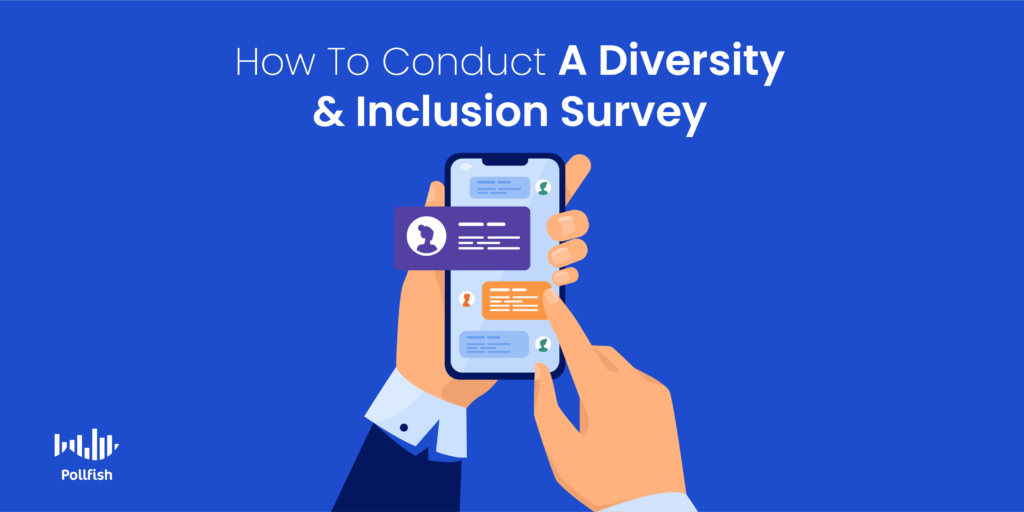
Conducting a diversity and inclusion survey may reveal challenges that alert businesses of any discrimination beforehand, helping companies take appropriate action and set policies, as needed, to address concerns and issues identified in the survey results.
However, to do so, it is essential to conduct D&I surveys in a proper way to get accurate results.
Here is how you can conduct a diversity and inclusion survey effectively.
Step 1. Understand the Scope and Purpose of the Study
Before you begin to structure your survey, you need to have a straightforward research question to define what answers you’re looking for and what goals you expect to achieve. Then, based on your main question, you’ll be better able to determine who you need to target in the survey.
Do you want to see if your policies and set standards are adequate, or are you trying to figure out diversity and inclusion-related prominent issues?
Understanding the scope and purpose of your survey improves the quality of deductions. Make a list of the issues and questions in your research and prioritize it.
Step 2. Involve the Relevant Team
Once you fully understand the scope and purpose of your surveys, it is essential to communicate and create a team that recognizes its importance to ensure they prioritize it.
Give your team a presentation to describe the importance and meanings of inclusion and diversity. Ensure that there is room for discussion, concerns, and questions. Make them feel heard, involved, and valued in the process.
Step 3. Set Up a Diversity & Inclusion Taskforce
It is imperative to set up a small diversity and inclusion task force for your surveys — a group of employees that come together routinely to talk about the latest developments as in what is working and what is not going well.
Step 4. Deploy the Surveys
Before sending out and distributing surveys, create a clear roadmap for when, where, and with whom you’ll conduct the study. Determine the number of responses you'll need beforehand, as part of your survey response rate and how you’ll access and analyze the sample population.
When you create a robust research plan to get answers to your research questions, you will be satisfied
and confident about sending out the survey according to your preferred method of choice – online, in-person, or by mail.
Step 5. Measure the Results
No matter which method you choose to analyze your diversity and inclusion survey results, it is vital to process the information accurately. You can do this by leveraging software that helps you sort the responses according to specific requirements.
You should refine the information by eliminating all the incorrect and incomplete responses. For instance, if you ask open-ended questions, it is essential to interpret the reactions by allotting labels to each respondent’s answers and structuring them into themes or categories.
You can also leverage some qualitative methods and approaches, like thematic analysis, more suitable to analyze interviews. Typically, you can conduct statistical analysis leveraging programs such as SPSS. The same set of survey data can be subject to many pieces of research.
Diversity and Inclusion Survey Questions – Tips and Examples
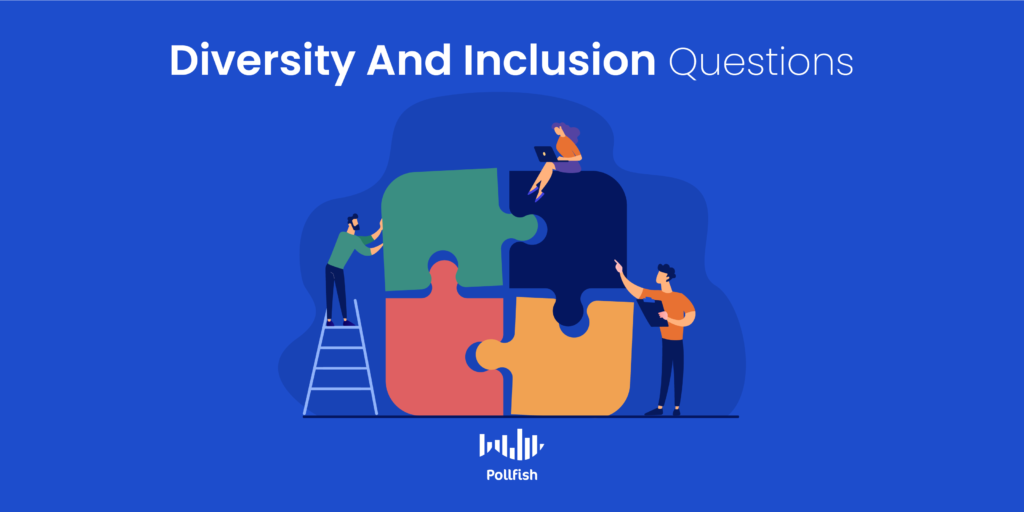
To get the most out of your diversity and inclusion survey, you must ask the right questions from the right audience. Give you people the opportunity to share their observations and experiences with a combination of questions leveraging the Likert scale to measure opinion and satisfaction and opinion.
Using the following questions for understanding employees' standpoint on fairness, respect, equity, diversity, and inclusion can help you gauge employee engagement and satisfaction.
- Does everybody have an equal opportunity to succeed in this company?
- Does the company leadership support the value of inclusion and diversity?
- Do all the employees in the company receive fair treatment?
- Does the company have a supportive environment for open and free expression of opinion, ideas, and beliefs?
- Do you feel empowered to make work-related decisions?
- Do you relate to any leaders in the organization?
- Does the senior leadership team reflect a diverse organizational outlook?
- Does your manager encourage all the employees to share different ideas, speak up, and be vocal about diversity and inclusion issues?
- Does your company value diverse ideas and opinions?
- Does your firm give raises, appraisals, and promotions equally and fairly to all employees?
- How can we ensure all the team members feel valued and heard?
- How can you improve inclusion and diversity in the company?
Measuring Diversity and Inclusion Using Survey Data
For some companies, mounting diverse and inclusive initiatives may seem like a multi-faceted endeavor. However, it is vital to pay attention to this aspect to ensure a healthy and motivating workplace for all employees alike.
Diversion and inclusion surveys are paramount to a company’s overall strategy. It helps reveal representation and unfairness gaps within your organization.
Tailored surveys help organizations effectively reach their diversity and inclusion goals by garnering employee feedback and benchmarking the current status.
Tailored employee feedback surveys help organizations effectively reach their diversity and inclusion goals. Most importantly, they enable you to take a more meaningful approach to cultivate a more diversified culture.
Along with this, you can conduct employee recognition surveys that boost employee morale, in turn, helping you scale your business.
With the help of a professional survey platform, it becomes easier to distribute the surveys to your employees. Moreover, by using an inclusive design for such research purposes, you can make your employees feel visible. Launch your survey today!
How To Conduct Financial Market Research Like a Pro
How To Conduct Financial Market Research Like A Pro
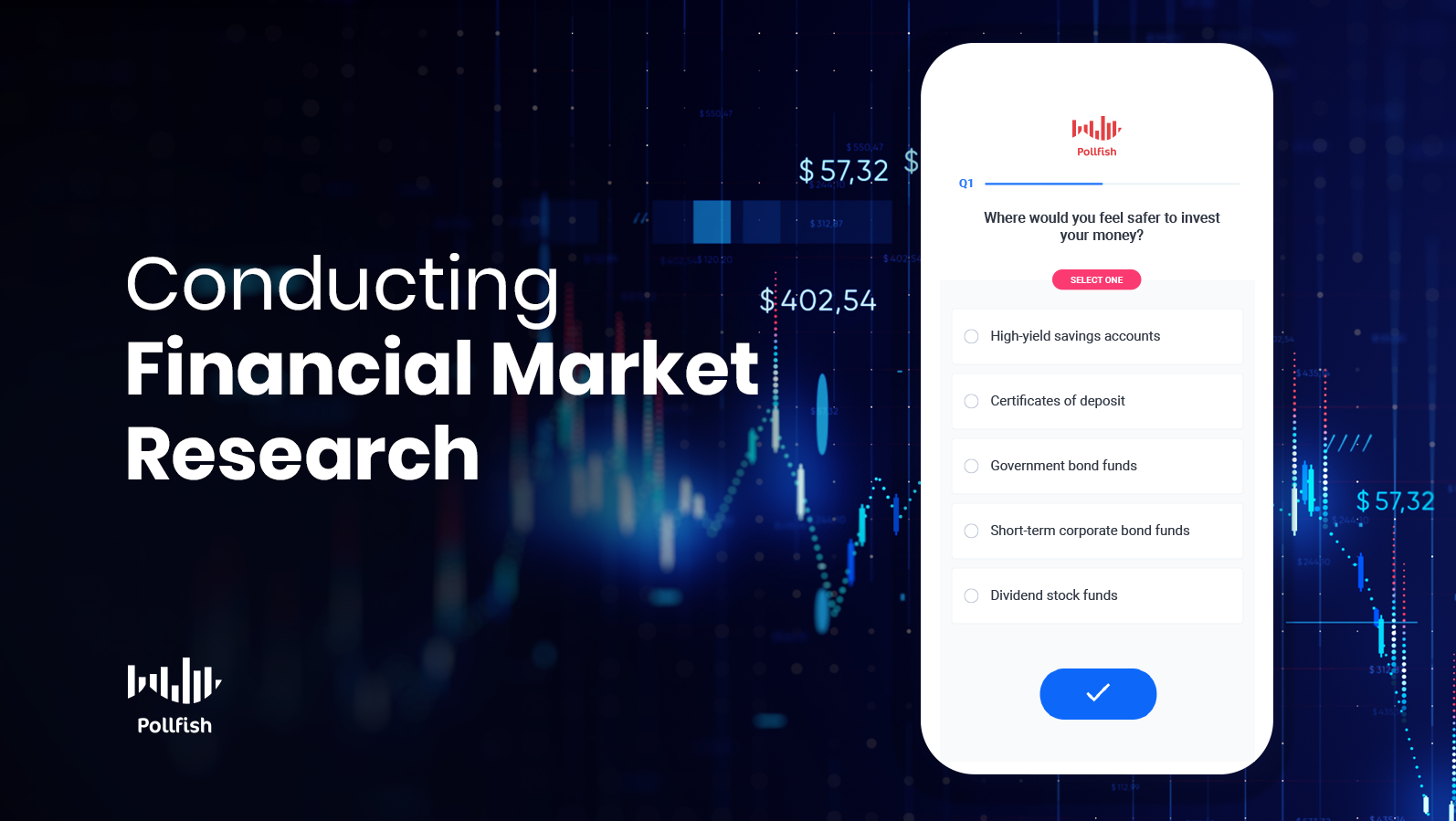
Financial services providers need to integrate financial market research into their business strategy. This research supplies providers in this vertical with meaningful insights on their target market, market products, and services.
Moreover, this data grants and gives financial services providers a framework for decision-making. As these institutions have to deal with money, there’s a lot at stake for banks and money lending companies.
In 2019 alone, the global financial services industry spent an estimated $50 billion extracting raw data to support their trading activities and transactions.
This is because financial market research data enables them to forecast and analyze any trends or aspects of the organization that needs changes. Not only this, market research offers opportunities for investments that increase the profits for an organization.
Even in 2020, when the pandemic brought the entire world to a standstill and disrupted the global economy, financial market research helped finance leaders and the financial services industry to support the economy’s financial recovery.
The Rising Importance Of Financial Services Industry
As aforementioned, the financial services industry is the main driver of a country’s economy, mainly dominated by large organizations. With a strong financial services sector, the nation’s economy grows, and the consumers earn more, thereby increasing their purchasing power.
The uncertainty brought about by the global pandemic means that potentially every company and organization is likely to make smart and bold financial decisions. Unlike the financial crisis of 2008, the 2020 pandemic has disrupted all aspects of the economy. This means that finance leaders and the financial services industry are strategically positioned to support the economy’s financial recovery.
With the recent changes in technologies, the rise of new investment trends, and the significant shift in consumer behavior, financial services companies are forced to tap into valuable information to approach these changes.
Moreover, companies need to leverage relevant data and insights to make the most of these opportunities to keep up with the recent digitization and innovation in the financial services industry.
This means that market research is as crucial for the finance sector as any other industry.
The Importance of Conducting Financial Market Research

Financial markets play a crucial role in driving a country’s economy and offering countless opportunities for investors to tap into specific markets and services. But with changing regulatory demands and consumer requirements, financial services companies and organizations need unique insights to keep up with this changing industry.
Financial market research is essential because it can help break down market data and trends into a broader context that offers finance companies a clear perspective of the risks and benefits of a particular service.
Therefore, several financial services providers invest in data analytics and market research to gain valuable information about their customers.
However, conducting accurate research is not easy. Lenders, bankers, real estate brokers, and all other kinds of financial services providers need to know precisely what kind of information will help them in decision making.
For commercial banks and investment companies, market research is essential as it determines which business proposition can benefit them in the long run. Moreover, it helps brokerage firms assess which products are in demand by their customer base so that they can suggest them based on the individual requirements of their customers.
The following expounds on why a financial market analysis is important for banks and other businesses for their decision-making process:
Reduced Business Risks
When it comes to investing money, businesses need to know the right time to invest. With financial market research, they can predict the value of their investment to reduce business risks. Developing a financial plan that outlines all the risks and benefits that a firm may incur can give financial services providers an idea of which opportunities to invest in.
Understanding these trends is also important so firms know exactly how to respond to market changes. Some frequent research areas for financial services providers include:
- Insurance
- Business Banking
- Personal Loans
- Mortgages
- Property Management
Effective Forecasting And Analysis
Accurate financial forecasting is crucial for financial service providers to strategize in the face of any uncertainties that may affect their business. Thus, financial market research equips businesses and institutions in their strategic planning process.
This kind of research also provides deep insights into customer behavior and market shifts due to external factors and variations in market trends. With thorough finance market research, supported with effective survey campaigns, businesses can tap into what their customers are doing to offer something unique that sets them apart in the industry.
It enables financial service institutions to set realistic and feasible goals and helps them predict their annual budgets.
Accurate Demographic Targeting
To know their ideal demographic, businesses need effective financial market research to assess their target market and what they require from their business. This kind of research is also useful for understanding the distribution of consumer spending over a particular period and how customers feel about their financial situations.
Financial service providers should inquire of their target market as such: are its members willing to make financial deals with your business at this time of crisis? How have their spending and saving plans changed?
Adequate financial research will delve into all these behaviors and trends at length to help institutions make better decisions. It also provides insights into demographic spending trends, where customers look for financial guidance and receptivity to media.
Internal Audit Assistance
Businesses can evaluate the trading activities, existing credits, and regulatory reports for a successful internal audit by assessing financial market conduct.
The interconnectedness within the financial system has made it necessary for institutions to analyze their vulnerability to systemic risks by assessing and analyzing macro-economic factors, industry trends, changes in regulations, risks materializing at other entities, and innovation by peers.
Carrying out an internal audit for a company offers a detailed report on the market's existing and predicted financial risks. The interconnectedness of different industries and systematic risks in the economy brought about by the pandemic have made it imperative for financial services providers to put forward a dynamic audit plan. And the only way an audit plan will be successful in pointing out a company’s vulnerabilities is with adequate financial market research.
How To Conduct Financial Market Research

The following are two foremost methods for conducting financial market research:
Primary market research methods for the finance industry
Primary market research for the finance industry involves the direct participation of financial services providers in the research. It offers valuable data on different market areas that providers may require, as obtaining firsthand data provides them with unique insights, particularly their study. This is of utmost importance as secondary research providers do not provide data into the particular inquiries and topics of study that a financial services provider seeks.
Some of the methods to conduct primary market research for the finance industry include:
- Interviews – Financial services providers can hold interviews with industry participants to ask questions that require deep understanding. This is important to assess the changing preferences of clients for different financial services
- Observations – This is a qualitative, no-interaction technique used by financial advisors that can help them gain useful insights regarding the practices followed by finance companies, their competitors, and customer trends
- Email surveys – Financial advisors can contact industry participants and get feedback through a survey that includes short questions. These responses can then be analyzed and compiled as a report to understand market trends
- Online Surveys – They prove to be an essential tool within market research techniques as they collect data and insights on the exact amount of respondents to use in a survey pool. Online surveys can also support a company’s decision-making processes and offer them a competitive advantage through fast quality data. By accessing the right platform for generating online surveys, the financial services providers access qualitative and quantitative surveys.
Secondary market research methods for the finance industry
Secondary market research for the finance industry relies on data and information that researchers extract, meaning that the data has already been conducted by a third party and made available.
Some of the methods to conduct secondary market research include:
- Industry Reports – Industry reports identify any opportunities or risks that the industry might face and present scenarios from the past that can help financial advisors deal with threats in a better way
- Case Studies – Case studies illustrate how industries dealt with financial crises in the past and can provide a detailed, in-depth investigation into a complex situation. They are perfect for providing you with real-life examples of industries and actionable insights
- Statistics sites – Statistical research can help you decide which data collection methods would garner maximum results, what decisions to make, and how to predict behavioral response based on past statistical reports
- Research papers – Research papers provide in-depth knowledge on a particular topic that helps financial services providers understand and make better decisions
- Research agencies – Research agencies know all the proper tactics for conducting market research. They can help financial advisors with information such as client preferences, the right target market, predicting future financial conditions, etc
However, the type of research method financial advisors choose depends highly on time and available data. Qualitative market research like interviews and participant observation offers detailed, rich information and takes some time to collect. On the other hand, surveys and online feedback are easy to collect and lack necessary details.
Secondary Market Research For The Finance Industry
The following is the list of the best secondary market resources on important data and insights on the finance industry.
It offers a general overview of the financial services industry, from money management to digital banking technologies. Also, it outlines all the major trends, topics, and behaviors needed for companies to climb up the ladder in the financial sector.
Includes reports on the latest financial market research and provides analytical data on different financial subjects such as insurance management and consumer spending/saving patterns.
Compiled by IBIS World, this website is a massive database of thousands of industries. It presents useful information on economic changes, demographic data and helps organizations make better financial decisions.
This website provides press releases, publications, and reports on banking and financial services. Given the devastating impact of the pandemic on the financial sector, the reports on MarketsAndMarkets also offer strategic, tactical advice on using financial services to help companies recover from their losses.
The Business Research Company is the most authentic report on the internet that provides detailed reports on different industries in the market. It presents past trends and how markets have changed in the past decade and predicts statistical information on financial services providers.
Financial market research enables the finance industry to gain meaningful insights into different products and services. This increases sales opportunities and offers businesses all the information they need to design effective financial strategies.
Carrying Out Effective Research in the Financial Sector
Financial market research enables the finance industry to gain meaningful insights into different products and services. This increases sales opportunities and offers businesses all the information they need to design effective financial strategies.
Online surveys are the most convenient method for collecting data owing to their accessibility and accuracy. This is why financial services providers need to leverage the power of an online survey platform or market research experts so that they can target a vast audience base and generate reliable survey responses.
To improve data quality, advanced online surveys leverage machine-learning to highlight and eliminate poor quality responses. AI in market research reduces the chances of error and eliminates duplicate entries of data that might result in outdated information and poor data quality.
These online surveys are then used in random device engagement sampling (RDE)to engage a huge customer base on devices they are already using. Whether these surveys are posted on mobile apps or gaming interfaces, they are placed where the business’s audience can easily respond to them. This way, they can tap into unique and high-quality market research data that drives their decision-making process.
Frequently asked questions
What is financial market research?
Financial market research offers useful insights into financial trends and strategies and gives statistical information on the leading finance companies. It also provides actionable insights regarding various financial instruments like portfolio pricing, risk management, etc.
Why do businesses need to conduct financial market research?
Financial market research minimizes the risk for financial services providers and identifies new business opportunities for them. It also gives them insights into market trends, identifies problem areas in the market and untapped resources.
How can an online survey platform help businesses with financial market research?
Online surveys are a reliable way of getting insights directly from consumers. They are also affordable and require minimal to no investment.
What are some of the resources to find secondary research on the finance market?
Secondary market research sources include the web, media sources, industry reports, case studies, press releases, publications, and company compiled data.
Do businesses need a financial advisor?
Even though many business owners choose to conduct their research, financial advisors can offer a solid, strategic plan that takes all their previous, present, and future investments into account and provide them with the most feasible plan. Moreover, financial advisors are experienced in their job and know a lot more about financial market trends than business owners that can help in effective decision making.
How a Major Global Electronics Manufacturer Quantified the Podcasting Market
Case Study:
How a Major Global
Electronics Manufacturer
Quantified the
Podcasting Market

Summary
Bringing innovative products and services to market is
always a race in today’s market,
where the possibility of a “fast-follower” becoming a market leader is increasingly rare, especially in
mobile communications. That’s why a major consumer electronics conglomerate needed to make
sure that it had an agile partner like Pollfish, one that could provide real-time quantitative data to
inform day-to-day decisions as it prepared to launch its first home screen widget for podcasts.
About the Global Electronics Customer
As a global mobile industry market leader with a sweeping market share, the consumer electronics company that utilized Pollfish strives to provide new and differentiated user experiences through innovations with purpose. Its proud heritage of over a decade of research and development has brought about various innovative technologies to the world
About Pollfish
Pollfish (www.pollfish.com) is an agile market research platform offering real-time responses from mobile consumers.
Using a modern sampling methodology called Organic Sampling that merges mobile delivery, artificial intelligence, and a massive audience network, Pollfish is able to narrowly target highly specific audience segments within their audience network of over 650M global respondents, spanning 160 countries and 51 languages, with better data quality and faster completion times than competitive survey solutions. Trusted by brands, media companies, and agencies alike, Pollfish data has powered stories in almost every major news source in the US, including The New York Times, Washington Post, and Inc.
Mobile Delivery
Artificial Intelligence
Massive audience network

The Opportunity
Podcasting has grown from being a thing for 22% of the United States in 2006 to 75% in 2020,
There are no signs of the COVID pandemic slowing it down (Statista 2020). Consumption is expected to grow at a robust rate as well, even among traditionally disenfranchised (hard to reach) demographics (e.g., women, non-whites, millennials).
Given the ubiquity of podcast player technology, there is an opportunity to innovate and capture market share.
This is because this medium is surprisingly utilitarian, fragmented and undeveloped, and podcast clients only support basic use case scenarios. But even with this defined opportunity, the consumer electronics company needed a way to quantitatively structure the details of product feature sets into business results. And that’s where Pollfish came in.


Not Boiling the Ocean
The major electronics brand had a wide range of potential feature sets that its product team could have pursued, so it used Pollfish to gather quantitative data and map feature sets into quadrants.
For example, feature set “A” could plot on one axis based on aggregate market appeal and plot on the other axis based on investment levels for that feature set. This approach allowed it to quickly define a minimum viable product (MVP) and focus attention on differentiating opportunities, versus “table stake” features or niche opportunities. Trade-offs became immediately clearer because the company was able to measure the relative importance of feature sets to target markets and impute business impact.
A key feature that makes Pollfish the best partner for this process is agility.
For example, it was not unusual for the product team to need additional attitudinal data on a particular market segment (e.g., college females) – to drive a decision at an upcoming meeting. Pollfish does not simply extract faster responses from legitimate users (because of our unique, mobile-first methodology), but it reaps insights more quickly through features like robust pre-survey filters and post-stratified views.
Product development would often need insights within three days, and Pollfish is always more than up to the task.
~ Sr Manager of Consumer Insights
A New Method
A primary reason why Pollfish is far more agile is by way of an advanced approach to collecting respondents. Called random organic sampling, this method engages random site and mobile app visitors in their natural, voluntary digital spaces. Specifically, Pollfish employs Random Device Engagement (RDE), our signature method that falls in opposition with non-random sampling, such as survey panels, an offshoot of traditional surveying.
Traditional surveys are completed by “professional survey takers,”
(such as the survey panels) who answer surveys by answering emails and/or logging into websites. These respondents are amassed into communities that have disproportionate numbers of stay-at-home parents (“coupon moms”) and college students (in search of beer money).

In contrast, Pollfish does not pre recruit panelists and other respondents. Rather, it implements Random Device Engagement (RDE) to garner qualified respondents randomly.

To achieve this, Pollfish partners with over 140,000 mobile/web developers to distribute surveys to over 650M users worldwide.
(That’s over 8% of the world population, by the way!) Users respond to surveys in the apps/websites where they are already spending their time, and get rewarded for responding with things (e.g., lives, points, etc.) in the app/website they care about.
Catching people where they are (in their favorite mobile apps) improves responsiveness and reduces bias from “professional survey takers”,
as well as other common survey scenarios. Although survey completion rates may decline with organic sampling, gains in data quality more than compensate for it.
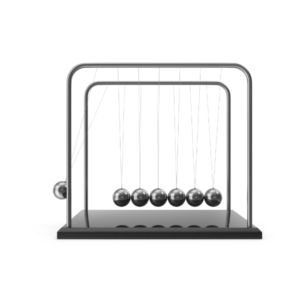
Pollfish earned the confidence of the electronics brand by delivering reliable and quality results because we eliminate the biases of traditional panels
That’s why our electronics customer can liberally place open-ended questions in every Pollfish survey, as it leverages our platform features like “gibberish” and other quality filters.
The end result is that the global electronics company found a market research platform uniquely suited to meet its agile, high-quality insight and global deployment needs from Pollfish.

Results
With Pollfish, this leading consumer electronics company is able to quantify the podcasting market
by understanding how each market segment prioritizes different feature sets. Whether by gender, age, socio-economic status, or even mobile phone operating system (all of which, incidentally, are default filters available on Pollfish) – the electronics brand quickly identified and evaluated how market segments valued every potential podcasting feature set.
Each time the prioritization of a feature question came up for debate, our electronics customer knew exactly which market segment(s) were likely to be impacted– and the business impact those market segment(s) could drive. With this data, defining a minimum viable product became a much more straightforward process and developing a product roadmap became a much more agile process.
Surfacing key differentiators and the value proposition of the electronics customer, in general, was also a natural outcome of this real-time and ongoing market research activity. For example, the mismatch between average podcast length and average user time per session made the all-important need for parsing functions (like defining chapters, creating summaries) very clear.
The best outcome is that, because the electronics provider continues using Pollfish as an integrated part of its ongoing operations, insights are not a static data point considered once and forgotten – but a dynamic and continuously validated part of its business.

Build Your Ideal Survey with Survey Templates
Build Your Ideal Survey with Survey Templates

There are myriads of ways to construct your survey campaign and its corresponding surveys. While it is wonderful to use an online survey platform with so many survey capabilities, it can also be overwhelming to decide on and create the proper survey.
The new Survey Templates feature from Pollfish changes that.
Whether you’re stumped on deciding on the proper survey to use, or you don’t know how to begin creating it, the new Survey Template feature is here to assist you, easing the survey creation process and bringing you closer to agile data.
You can choose from a batch of 17 survey templates, which touch on different campaign categories to help you gain insights for any business campaign, from branding to product and more. Researchers can now schedule templated surveys to launch as either single-use or as reoccurring trackers.
This new feature enhances and simplifies the survey process, so that you can focus your time on what matters most, whether it is ideating campaign ideas, analyzing the survey data or working on other projects.
This article explains the new Survey Templates feature, so that you can optimize your survey development process immediately.
Understanding Survey Templates
Survey Templates is the latest feature from Pollfish, allowing researchers to create surveys with the aid of 15 survey templates. These templates are categorized by both general business campaigns and survey campaign types.
From general advertising and branding campaign survey templates, to hyper-focused logo testing and two kinds of Net Promoter Score (NPS) survey templates, there are templates for virtually every department.
Our survey templates are not solely for market research; you can use them to gain feedback from your site visitors and your own team. This is because we offer the website feedback survey template to examine your site users, along with various employee survey templates.
We also offer the event evaluation survey template to help you understand your event marketing efforts. Moreover, aside from the business world, our surveys can be used in the realm of education, as we offer a template for evaluating university instructors.
The Survey Templates feature offers all the flexibility as every other interface in our dashboard. That’s because when you select a template, the platform allows you to edit, add and remove anything you’d like, much like our predefined answers and other functions.
As such, you’re not rigidly tied to any question, answer, order of questions and other functionalities. You are completely free to customize your template as you wish, whether it involves editing the question and answer wording, reordering the questions, adding new ones, or deleting certain items and all else.
In short, you are in full control of the design and setup of your survey with these templates. They are simply there to help you gain survey ideas and put together your survey to save you time.
The Categories of Survey Templates
Presently, this feature offers five categories of survey templates. These help you organize your templates and stay on track. Each category offers different templates; there may be some overlap, as some templates can be used across different campaigns and purposes.
The following lists the 5 categories of survey templates we currently feature:
- Brand feedback
- Product feedback
- Customer feedback
- Employee feedback
- Generic
- These include surveys for educational settings and miscellaneous survey types.
There is also the parent category option of “templates,” which displays all the survey template categories when you select it.
Various categories include the specialized survey type of A/B testing and the NPS survey. This is because these surveys are versatile (as are many others) and can be applied to different campaigns.
The Survey Templates and Their Applications
As aforementioned, you can use this feature for various campaigns. Some templates are generic, while others are laser-focused. You can tailor each one to your favor and to your specific needs. Or, you can simply use the questions and answers that are included and preset.

The following lays out all of our survey templates, with specific attributes, use cases, campaigns/ applications and examples of corresponding surveys:
- Brand Awareness
- Purpose: Branding, brand visibility, recognition
- Campaign(s): Measuring awareness, comparing brand equity, raising awareness
- Survey example(s): brand equity survey, brand awareness survey
- Brand Perceptions
- Purpose: Branding, brand trust, brand opinions and sentiments
- Campaign(s): Measuring brand trust, building a brand advocate
- Survey example(s): brand tracking survey, brand perception survey, brand trust survey
- Advertising Testing
- Purpose: Advertising market research, Ad concept testing
- Campaign(s): Advertising, comparing ads, measuring emotional responses to ads
- Survey example(s): ad testing survey, concept testing survey, A/B testing survey
- Logo Testing
- Purpose: Branding, design, imagery assurance
- Campaign(s): Determining a logo, finding the proper images for different needs
- Survey example(s):
- Product Concept Testing
- Purpose: Concept testing,
- Campaign(s): Product campaigns, customer development, in-home use test
- Survey example(s): concept testing survey, A/B testing survey
- Customer Satisfaction Survey (NPS)
- Purpose: Customer satisfaction, customer feedback
- Campaign(s): Measuring customer satisfaction, minimizing customer effort
- Survey example(s): NPS survey, customer satisfaction survey, CSAT survey (Customer Satisfaction Score), CES survey (Customer Effort Score)
- Customer Loyalty & Relationship NPS
- Purpose: Consumer loyalty, brand trust, CLV,
- Campaign(s): Measuring customer loyalty, increasing loyalty, increasing brand advocacy, increasing and measuring customer lifetime value (CLV), building brand trust, driving repeat purchases
- Survey example(s): NPS survey, customer loyalty survey
- Employee Satisfaction
- Purpose: Employee feedback, employee satisfaction
- Campaign(s): Measuring employee satisfaction, finding what makes employees happy, finding ways to boost employee morale, improving employee performance
- Survey example(s): employee feedback survey, employee satisfaction survey, eNPS survey (Employee Net Promoter Score)
- Employee Engagement
- Purpose: Employee feedback, employee engagement
- Campaign(s): Measuring employee engagement, discovering employee preferences, discovering how to make employees more engaged, improving morale
- Survey example(s): employee feedback survey, employee recognition survey, employee burnout survey
- University Instructor Evaluation Template
- Purpose: University instructor feedback, curriculum feedback, opinions on teaching style
- Campaign(s): Assessing a professor/instructor’s teaching style, opining about the curriculum, measuring fairness of grading
- Survey example(s): Professor/Instructor feedback survey, college survey, university survey
- General Event Feedback
- Purpose: Event evaluation, event headcounts
- Campaign(s): assessing events, event performance, discovering issues with events, preparing for future events
- Survey example(s): event evaluation survey, event survey
- Website Feedback
- Purpose: Event evaluation, event headcounts
- Campaign(s): Understanding digital UX, measuring usability, understanding digital customer journeys, finding glitches
- Survey example(s): website feedback survey, UX survey, customer journey survey, user testing survey, customer experience survey
- Purchase Feedback
- Purpose: Buying experience, purchase touchpoint optimization
- Campaign(s): to understand customer buying behavior, foster repeat purchases, optimize buying touchpoints
- Survey example(s): product satisfaction survey, customer journey survey, post-purchase survey
- Return to Work
- Purpose: Employee feedback, return to work opinions
- Campaign(s): to compare working remotely with in-office work, to gain insights on improving in-office work, to understand why employees don’t want to return to the office
- Survey example(s): employee feedback survey, employee satisfaction survey, return to a workplace survey
- Remote Working
- Purpose: Employee feedback, rating remote working
- Campaign(s): to compare working remotely with in-office work, to gain insights on improving remote work, to understand why employees don’t want to return to the office, to assess comfort levels of possible hybrid or in-office working models
- Survey example(s): employee feedback survey, employee satisfaction survey, remote working survey
- Brand Diagnostic
- Purpose: Brand feedback
- Campaign(s): to obtain a comprehensive brand health assessment with key drivers of brand performance, compare prospects’ conversion through the funnel and compare it with other brands, to understand the reasons why prospects drop out at each stage in the funnel
- Survey example(s): brand tracking survey, brand reputation survey, brand health survey, brand equity survey, brand perception survey, brand trust survey
- Product Naming
- Purpose: Product feedback, brand feedback, customer feedback
- Campaign(s): to test your product name ideas with customers to understand how they affect their perceptions and likelihood of buying before you launch a new product, which includes finding the name of a new product, finding the name to an existing product and uncovering what comes to mind when respondents see certain names.
- Survey example(s): concept testing survey, A/B testing survey
How to Create and Use Survey Templates
It’s easy and intuitive to create and use survey templates on the Pollfish dashboard. All the templates are on one page, which you can filter based on categories. The search field also allows you to find exactly what you’re looking for without browsing through categories, if this is your preferred method of finding the correct survey template.
The following explains how to create and use survey templates in a step-by-step way:
- To begin your templated survey, click on the “Create Project” button on the top right of your dashboard
- Select “From Template” in the drop-down menu.
- Under each template, you have the option to click on the Preview button to see the questionnaire and a small description on the most opportune reason to use it.
- Once you find the template you’d like to use, click on the “Use this template” button on the bottom left panel.
- Then, type in the title of your survey.
- Select whether you want to buy responses from the Pollfish Audience Network or send the survey to your own list of respondents.
- Edit your survey template to your liking and needs.
- Run your survey as you normally would.
Forming the Most Ideal Surveys
The new Survey Templates feature allows you to set up a preset survey for various occasions, purposes and campaigns. It is just one way in which the Pollfish online survey platform is the most powerful on the make research tools market.
You need to use a strong online survey platform to easily create and deploy surveys to your target market, along with specific individuals.
You should use a mobile-first platform since mobile dominates the digital space and no one wants to take surveys in a mobile environment that’s not adept for mobile devices.
Your online survey platform should also offer artificial intelligence and machine learning to remove low-quality data, disqualify low-quality data and offer a broad range of survey and question types.
The survey platform should offer advanced skip logic to route respondents to relevant follow-up questions based on their previous answers.
Additionally, it should also allow you to survey anyone. As such, you’ll need a platform with a reach to millions of consumers, along with one that offers the Distribution Link feature. This feature will allow you to send your survey to specific respondents, instead of only deploying them across a vast network.
With an online survey platform with all of these capabilities, you’ll be able to form surveys for any campaign swiftly and efficiently.









